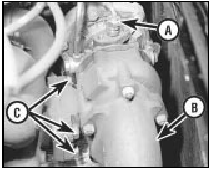Turbocharger- removal and refitting
Note: New gaskets and new tabwashers must be used on refitting.
Removal
1 Disconnect the battery negative lead.
2 Disconnect the turbocharger inlet and outlet air hoses and the hoses from the waste gate actuator and solenoid control valve at their turbocharger connections. Tape over all the disconnected unions and outlets to prevent dirt ingress.
3 Support the exhaust system and disconnect it from the turbocharger exhaust manifold .
4 Disconnect the oil feed union on the top of the turbocharger and the oil return line from underneath the unit (see illustration). Tape over all disconnected pipes and unions.

23.4 Turbocharger oil feed union (A), turbocharger exhaust manifold (B) and
retaining nuts (C)
5 Bend up the tabwashers, then unscrew the nuts securing the turbocharger to the exhaust manifold. Remove the unit and store it in a clean plastic bag while removed from the car.
Refitting
6 Before refitting the turbocharger ensure
that all mating faces are clean and obtain new
gaskets and a set of new tabwashers. It is
also advisable to renew the engine oil and
filter, particularly if a new turbocharger is
being fitted or if there was any sign of
previous oil contamination.
7 Refitting is a reversal of removal, but bearing in mind the following points: a) Tighten all retaining nuts to the specified torque and secure with the tabwashers.
b) Before connecting the oil feed union, prime the turbocharger bearings by injecting clean engine oil into the union orifice.
c) Crank the engine over on the starter with the ignition LT lead at the coil disconnected until the oil pressure warning light goes out.
See also:
Load apportioning valve (P100 models) - adjustment
Models before mid-April 1989
1 The vehicle must be unladen, at normal
kerb weight (a full tank of petrol, but no driver
or load).
2 With the vehicle standing on its roadwheels,
remove the spring ...
General information
All models utilise a light alloy inlet manifold
which on carburettor models is coolant
heated to improve the atomisation of the
fuel/air mixture.
The exhaust manifold is of cast iron
construction ...
Heated rear window aerial amplifier - removal and refitting
Removal
1 On some 1986 models onwards the radio
aerial is incorporated in the heated rear
window element, and to assist reception an
amplifier is fitted. This is located in the tailgate
adjacent ...
